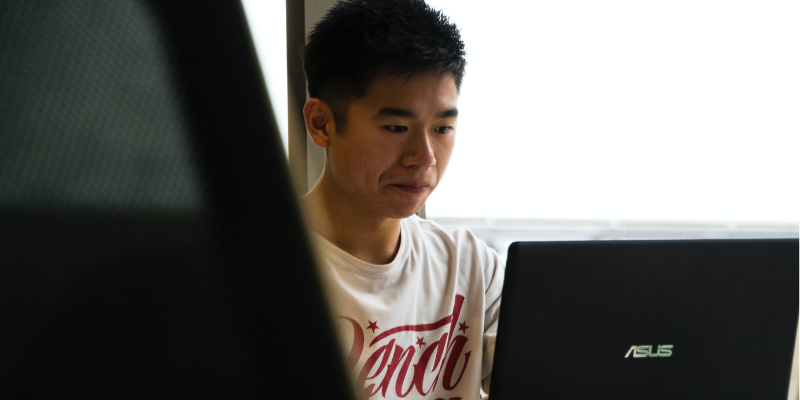
A conversation with global leaders on digital equity


.@ShaheenSaib89 & Beatriz Cano Buchholz spoke w/ Clarence Chua from @SingaporeMCI to learn about new initiatives to help promote #digitalinclusion after #COVID19 accelerated digitalisation of public services
Share article"The role of government is to better the lives and livelihoods of our people. We think that the most valuable role we can play is in helping everyone participate in this digital world confidently, safely and responsibly." @SingaporeMCI
Share articleEmbracing design thinking to produce customer-centric solutions, collaboration at local & national levels, and humility and an open mindset = Clarence Chua from @SingaporeMCI's top tips for #digitaltransformation
Share articleWe put our vision for government into practice through learning partner projects that align with our values and help reimagine government so that it works for everyone.
What connects Singapore’s food hawkers and its senior citizens?
As the COVID-19 pandemic accelerated the digitalisation of public services in Singapore and threatened to widen the digital divide, these were two groups that were particularly vulnerable to being left behind. In response, the Singapore Government established a number of initiatives as part of its wider efforts to promote digital inclusion.
To find out more about their work, we sat down with Clarence Chua, Director of Strategic Planning in the Ministry of Communications and Information, which plays a leading role within the Singapore Government in promoting digitalisation across society and economy. As part of a wide-ranging discussion, we heard more about the Singapore Government’s initiatives to promote digital equity, the role of collaboration at a local, regional and international level, as well as his top tips for those working on inclusive digital transformation.
Clarence began the conversation by explaining why the Singapore Government sees this as such an important issue.
“Digitalisation is pervasive, and it’s here to stay. As with the wider metaverse, more and more of us are spending increased amounts of our lives working, living, and playing in this digital space. The role of government is to better the lives and livelihoods of our people. We think that the most valuable role we can play is in helping everyone participate in this digital world confidently, safely and responsibly. Our goal is for the benefits of digital to extend to all parts of our population, society and economy, and ensure that no one is excluded from digital participation due to financial or literacy constraints. Addressing the digital divide is therefore extremely important.”
The role of government is to better the lives and livelihoods of our people. We think that the most valuable role we can play is in helping everyone participate in this digital world confidently, safely and responsibly.
While an absence of digital infrastructure or access to devices are common barriers to digital equity around the world, each country faces its own unique challenges.
“In Singapore, home broadband access rates are at 98%. The Singapore Government also has targeted schemes to subsidise devices and internet connectivity for vulnerable groups like low income households, senior citizens and people with disabilities. Our challenge is therefore not about digital access per se, but going beyond that to raise digital literacy and equip our residents with the necessary digital skills.”
As with many other countries around the world, COVID-19 threatened to widen the digital gap in Singapore. “So many things were shifted online and we realised that there were pockets of the population - particularly the more vulnerable groups - that were not necessarily able to make that move quickly and deftly.”
So, what did the government in Singapore do?
In June 2020, in the midst of the COVID-19 pandemic, they established the Singapore Digital Office (SDO) to drive government initiatives that accelerate digital adoption. Clarence expanded on two of the SDO’s initiatives which were launched in response to some of the inclusion issues that COVID-19 triggered.
“One key part of the SDO’s work was the ‘Seniors Go Digital’ programme. This involved mobilising digital ambassadors to train over 100,000 senior citizens, through one-to-one coaching and small group learning sessions.
“When it comes to digital skills building, we believe it’s important to start with foundational skills. For this group, it involved teaching them about how to navigate a smartphone interface. Our digital ambassadors also provided personalised instructions, or would sit with seniors and go through step by step how to go about learning how to use different apps.

“This programme really highlighted that there is a high level of interest in learning digital skills among senior citizens and there were a number of factors that helped make it successful. Firstly, we provided different options for learning, and used everyday language which these groups are comfortable with. In addition, our digital ambassadors were close to the ground, and were operating in locations that senior citizens regularly frequent, like libraries, community centres and so on. Rather than having them come to us, we went to them, which enabled us to reach a high number of senior citizens quickly.
“Another big part of the Singapore Digital Office’s work involved working with hawker centres. These are open air complexes in Singapore that house many stalls which sell a wide variety of affordably-priced food and are a large part of Singapore’s cultural heritage.
“We established the ‘Hawkers Go Digital’ programme which helped more than half of the 18,000 stallholders to adopt e-payments. There was an aversion towards handling cash due to COVID-19, so this initiative was really important in ensuring that consumers had the confidence to safely visit food stalls.
“For both of these programmes, we really tried to focus on the learning journey for these groups, identifying their pain points, their fears, where their confidence levels were, and customising the learning based on their needs. Those were quite critical learning points for us. It’s not about a cookie cutter approach, but where possible, about personalisation, and having a seamless experience for our users.”
In February 2021, we also launched the Digital for Life national movement which aims to build a digitally inclusive society in Singapore by galvanising the community to help citizens of all ages and walks of life to embrace digital learning.
Clarence described how collaboration - both across government departments as well as different sectors and the community - has been a vital part of the government’s approach.
“Taking a multi-stakeholder approach has been key to the SDO’s work. For example, for the ‘Seniors Go Digital’ programme, many of the locations where we trained senior citizens are run by other agencies, like the National Library Board, the Agency for Integrated Care, and the Silver Generation Office, which all had various touch points with seniors.
“Similarly, in the case of hawkers, the SDO worked very closely with the agency in charge of all hawker centres - the National Environmental Agency - as well as the Smart Nation and Digital Government Group, which has its own pool of ambassadors.
“In February 2021, we also launched the Digital for Life national movement which aims to build a digitally inclusive society in Singapore by galvanising the community to help citizens of all ages and walks of life to embrace digital learning. This movement is all about bringing together different stakeholders to come up with solutions that help address the needs of different parts of the population and community.”
Following their earlier success in supporting hawkers, the SDO and the National Environment Agency expanded their efforts to help hawkers benefit from technology by launching a Singapore Together Alliance for Action (AfA). AfAs are industry coalition groups that bring together people from the community, private and public sectors to work together on solutions to social and economic issues, and have been established in a number of different areas by the Singapore Government.
Bringing together these groups resulted in the Singapore Together AfA – Online Ordering for Hawkers. Launched in June 2021, the initiative supports hawkers to sell their products through online food delivery platforms.
“We realised that with the lockdowns, many hawkers were unable to reach consumers. So, we brought together the hawkers, food delivery platform operators and the community to work together to address the pain points and barriers to adopting online ordering options as well as to develop a sustainable business model that works for all players in the ecosystem.
“This is one example of how we’ve had to constantly evolve the focus areas of the SDO, but also illustrates how multifaceted digital inclusion is. It really requires us to take a step back and really understand the user experience, and be humble to realise that the government may not have all the solutions, but we do have a role to play in designing personalised and seamless digital experiences, especially for those who are not as digitally savvy.”
Digital equity is a truly global challenge that requires international collaboration if it is to be fully addressed. Clarence explained how the Singapore Government has been working with partners at a regional and international level to drive forward digital inclusion efforts.
“In South East Asia, we have been taking steps to promote digital inclusion and equity through the Association of Southeast Asian Nations (ASEAN). We have been championing practical mechanisms for cross border data flows. ASEAN members are also taking steps to develop better economic integration through the ASEAN Smart Cities Network (ASCN). As part of this we are developing an ASCN Online Platform where cities can exchange experiences and share best practices in growth areas such as digitalisation and the use of ICT.
“At a global level, our view is that setting digital standards and increasing cooperation would be significant in enabling more people to participate meaningfully in the digital economy. We have also found that building strong partnerships with global digital giants and other industry players can be a key starting point in promoting digital inclusion. For example, we worked with Google on Skills Ignition Singapore. This programme equips Singaporeans with in-demand digital skills to help them get into jobs. So far Google has worked with us to train more than 3,000 Singaporeans and helped them secure over 600 job placements.
“Beyond that we have government to government agreements like Digital Economy Agreements (DEAs). These are the equivalent of free trade agreements. We are trying to outline a clear and harmonised set of international rules that help promote interoperability between digital frameworks, which will help us build more digital utilities.”

There are a variety of skills that digital leaders need to successfully drive inclusive digital transformation in government. When asked about his advice for those working in this area, Clarence highlighted three key things:
Embracing design thinking to produce customer-centric solutions
“Design thinking, looking at the user experience and being able to put ourselves in the shoes of our citizens is vital in order to be able to design customer-centric solutions.
“It is really about dissecting the user journey, and in certain cases the learning journey, for different individuals. In the case of Singapore, this is where the digital ambassadors of the SDO come in. They have a better appreciation of the customer journeys that they have curated for different archetypes. They can apply this in terms of learning modules like e-payments, e-commerce, or in terms of educating citizens in how to scan QR codes, and so on. Digital leaders need to embrace UX and design thinking more generally.”
Collaboration
“Being open to “outsourcing” and collaborating with a much wider set of stakeholders is also hugely important, because the challenge at hand surpasses the capacity that governments have. We can’t solve all of these problems by ourselves, so governments need to harness the resources and capabilities of both the public and private sector.”
Humility and an open mindset
“Lastly, from a personal perspective, given how dynamic and fast evolving the digital domain is, we really don’t know what we don’t know. It is important to have humility and recognise that there are unknown unknowns. Rather than imagine that we can develop all the solutions right from the start, we need to adopt a flexible and adaptable mindset to solving problems which requires us to sensemake, probe and then respond. That demands a mindset shift and perhaps even a paradigm shift in how we approach digital.”





